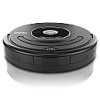iRobot Roomba 570 Service Manual - Page 73
Appendix G: Power Supply Test Procedure, Appendix H: Home Base Test Procedure
 |
View all iRobot Roomba 570 manuals
Add to My Manuals
Save this manual to your list of manuals |
Page 73 highlights
Appendix G: Power Supply Test Procedure For 1.25A Power Supply Equipment: AC Voltmeter, brick). DC voltmeter, ammeter, variable voltage AC supply, power resistor (18 ohm 50 W for 1.25 A charging Method Plug power supply into variable voltage AC supply with AC voltmeter connected across AC supply. Connect resistive load (18 1. ohm 50 W) across output of power supply, with DC ammeter connected in series to measure current supplied to load. Connect DC voltmeter across resistive load and ammeter, so ammeter voltage drop is included in voltage reading Set AC supply voltage for 240, 132, 108 and 60 VAC. 2. Failure if DC output voltage is not between 21.1 VDC and 24 VDC. Failure if DC output current is not between 1.0A and 1.45 A. Plug Power Supply into wall outlet or AC supply (120 - 240VAC). Measure open circuit voltage, idle current and power 3. Failure if DC output voltage is not between 21.1 VDC and 24 VDC. Failure if DC output current greater than 18 mA; Failure if Power is greater than 0.5W. Disconnect power supply from wall outlet or AC supply. Set AC supply voltage for 60 VAC. Reconnect power supply to AC 4. supply. Failure if output current isn't zero (power supply should shut down) Appendix H: Home Base Test Procedure Home Base Failure if it is shaken and something is loose inside or if contacts do not spring back Home Base Failure 'Power' LED on the Home Base is not lit or 'Docked' LED is lit when only plugged into Power Supply. Home Base Failure if open circuit voltage is not between 2.3 VDC and 3.8 VDC. Home Base Failure if it fails Home Base Mobility test (manual dock and Home Base avoidance) 73













